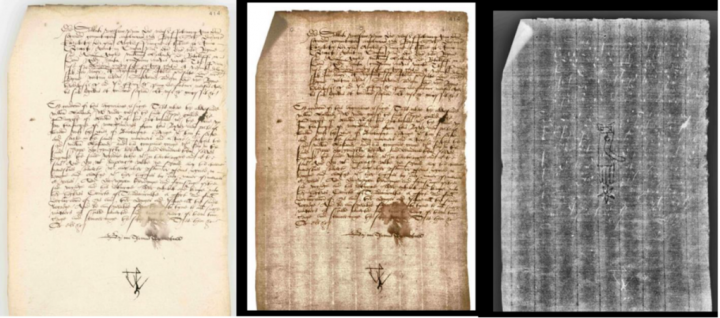
Watermarks are images imprinted in paper that appear lighter when viewed in transmitted light, as they are thinner and therefore more transparent areas in the bulk of the sheet. They are made by means of pieces of wire bent into filigree designs that are tied or sewn to the wire mesh of the paper mould, where the paper pulp is left to drain.

Examples of watermarks found in the collection at The National Archives
A video explaining the paper making process and showing the creation of watermarks can be seen here.
Watermarks were used by paper mills as trademarks or to distinguish different batches or grades of paper. They are useful features for paper historians, as they can be used for dating, determining the quality of paper, and identifying paper mills and their locations.
However, watermarks can sometimes be elusive to visualise and record. Traditionally at The National Archives watermarks were viewed on a backlit table and recorded by hand drawing them on tracing paper.
The Collection Care department at The National Archives is now experimenting with new imaging methods to enhance the visibility of watermarks in historic documents. We use a multispectral imaging system that automatically acquires an image of the sheet of paper with reflected light, and another one with transmitted light, and combine both of them in a phase-shift greyscale image where the watermark is enhanced.
This method is allowing us to explore and record the watermarks in our collections in an easy, safe and quick way, revealing the great variety of marks present in the documents.

An example of the process used to enhance the watermarks. Left: an image taken with reflected light. Middle: an image taken with transmitted light. Right: combined image in a phase-shift greyscale, which enhances the watermark
We are also looking for new methods to search this digital collection of watermarks, for example by uploading an image of an unknown watermark and outputting a ranking of the best visual matches of similar watermarks of known date and origin.
We are doing this by using computer vision tools such as VISE, an open source software developed by the Visual Geometry Group of the University of Oxford, that uses SIFT features to search a large collection of images using regions of an image as a query.
The experiments with VISE have had relative success, but there are still challenges to solve, as images of watermarks can be obscured by text in the document or by the poor condition of the paper, which would compromise the visual search.
Other computer vision approaches will be explored and the possibility of searching watermarks in cross-domain databases (including line drawings, rubbings, transmitted light images, beta radiographs) will be investigated.